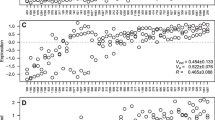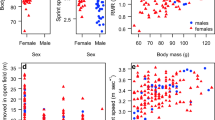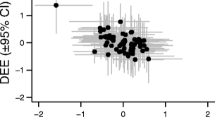Abstract
Although locomotor performance and behaviour are closely linked to survival in many wild animals, our understanding of the potentially important co-adaptations between locomotor performance and behaviour is still limited. Our objective was to quantify the among-individual correlation (rind) and within-individual correlation (re) between locomotor performance and personality traits in wild eastern chipmunks (Tamias striatus). We repeatedly measured sprint speed, docility, and exploration behaviour and found that all traits were significantly repeatable. Sprint speed was not correlated with docility and time spent in the centre of the open field. However, sprint speed was significantly and negatively correlated with distance moved in the open field at both the among-individual (rind = − 0.59) and the within-individual (re = − 0.54) levels. Thus, individuals with high locomotor performance are less explorative in a novel environment, which is somewhat counter-intuitive and opposite to the predictions generated by the pace-of-life syndrome and the “phenotypic compensation” hypotheses. Our results suggest that sprint speed and exploratory behaviour are co-specialised traits as they can reinforce each other’s effects in reducing predation risk. In refuging species such as chipmunks (i.e. individuals have to leave a refuge to forage), low exploration levels may reduce exposure to predators and high sprint speed may further reduce the probability of capture given an encounter with a predator. Thus, looking at how locomotor performance and behaviour interact and contribute to fitness is key to understanding the multivariate architecture of—and co-adaptations among—ecologically relevant complex phenotypes.
Significance statement
A large number of studies have looked at the relationships between locomotor performance and behaviour at the inter-specific, among-individual, and within-individual levels, with mixed results. We found a significant and negative relationship between sprint speed and distance moved during an open-field test, which goes against the prediction of the pace-of-life syndrome and the “phenotypic compensation” hypotheses. Instead, these results support the “trait co-specialisation” hypothesis. In refuging animals such as chipmunks, reactive behaviours (being shy and less exploratory) may reduce exposure to predators and high sprint speed may further the probability of escaping given an encounter with a predator. Taken all together, the negative among- and within-individual correlations and sensitivity to the same covariates (parasites, and to a less extent body mass) suggest that sprint speed and exploratory behaviour are co-adapted in eastern chipmunks.



Similar content being viewed by others
References
Adriaenssens B (2010) Individual variation in behaviour—personality and performance of brown trout in the wild. PhD thesis, University of Gothenburg
Araya-Ajoy YG, Mathot K, Dingemanse NJ (2015) An approach to estimate short-term, long-term and reaction norm repeatability. Methods Ecol Evol 6:1462–1473
Archer J (1973) Test for emotionality in rats and mice: a review. Anim Behav 21(2):205–235. https://doi.org/10.1016/S0003-3472(73)80065-X
Arnold SJ (1983) Morphology, performance and fitness. Am Zool 23(2):347–361. https://doi.org/10.1093/icb/23.2.347
Bauwens D, Thoen C (1981) Escape tactics and vulnerability to predation associated with reproduction in the lizard Lacerta vivipara. J Anim Ecol 50(3):733–743. https://doi.org/10.2307/4133
Bell AM, Sih A (2007) Exposure to predation generates personality in threespined sticklebacks (Gasterosteus aculeatus). Ecol Lett 10(9):828–834. https://doi.org/10.1111/j.1461-0248.2007.01081.x
Bennett GF (1972) Further studies on the chipmunk warble, Cuterebra emasculator (Diptera: Cuterebridae). Can J Zool 50(6):861–864. https://doi.org/10.1139/z72-116
Blumstein DT, Runyan A, Seymour M, Nicodemus A, Ozgul A, Ransler F, Im S, Stark T, Zugmeyer C, Daniel JC (2004) Locomotor ability and wariness in yellow-bellied marmots. Ethology 110(8):615–634. https://doi.org/10.1111/j.1439-0310.2004.01000.x
Blumstein DT, Lea AJ, Olson LE, Martin JGA (2010) Heritability of anti-predatory traits: vigilance and locomotor performance in marmots. J Evol Biol 23(5):879–887. https://doi.org/10.1111/j.1420-9101.2010.01967.x
Boon AK, Réale D, Boutin S (2007) The interaction between personality, offspring fitness, and food abundance in North American red squirrel. Ecol Lett 10:1094–1104
Brommer JE, Class B (2017) Phenotypic correlations capture between-individual correlations underlying behavioral syndromes. Behav Ecol Sociobiol 71(3):50. https://doi.org/10.1007/s00265-017-2278-4
Butler D, Cullis BR, Gilmour AR, Gogel DJ (2009) ASReml-R reference manual, release 3.0. VSN International Ltd, Hemel Hempstead, UK
Careau V, Garland T Jr (2012) Performance, personality, and energetics: correlation, causation, and mechanism. Physiol Biochem Zool 85:543–571
Careau V, Wilson RS (2017a) Of uberfleas and krakens: detecting trade-offs using mixed models. Integr Comp Biol 00:000–000
Careau V, Wilson RS (2017b) Performance trade-offs and ageing in the ‘world’s greatest athletes’. Proc R Soc B 284(1860):20171048. https://doi.org/10.1098/rspb.2017.1048
Careau V, Réale D, Humphries MM, Thomas D (2010a) The pace of life under artificial selection: personality, energy expenditure and longevity are correlated in domestic dogs. Am Nat 175(6):753–758. https://doi.org/10.1086/652435
Careau V, Thomas DW, Humphries MM (2010b) Energetic cost of bot fly parasitism in free-ranging eastern chipmunks. Oecologia 162(2):303–312. https://doi.org/10.1007/s00442-009-1466-y
Careau V, Montiglio PO, Garant D, Pelletier F, Speakman JR, Humphries MM, Réale D (2015) Energy expenditure and personality in wild chipmunks. Behav Ecol Sociobiol 69(4):653–661. https://doi.org/10.1007/s00265-015-1876-2
Clarke MF, Dasilva KB, Lair H, Pocklington R, Kramer DL, McLaughlin RL (1993) Site familiarity affects escape behavior of the eastern chipmunk, Tamias striatus. Oikos 66(3):533–537. https://doi.org/10.2307/3544949
Cooper WE Jr, Vitt LJ, Hedges R, Huey RB (1990) Locomotor impairment and defense in gravid lizards (Eumeces laticeps): behavioral shift in activity may offset costs of reproduction in an active forager. Behav Ecol Sociobiol 27:153–157
da Silva KB, Mahan C, da Silva J (2002) The trill of the chase: eastern chipmunks call to warn kin. J Mammal 83(2):546–552. https://doi.org/10.1644/1545-1542(2002)083<0546:TTOTCE>2.0.CO;2
DeWitt TJ, Sih A, Hucko JA (1999) Trait compensation and cospecialization in a freshwater snail: size, shape and antipredator behaviour. Anim Behav 58:397–407
Diamond K, Trovillion D, Allen KE, Malela KM, Noble DA, Powell R, Eifler DA, Gifford ME (2014) Individual (co)variation of field behavior and locomotor performance in curly tailed lizards. J Zool 294(4):248–254. https://doi.org/10.1111/jzo.12175
Dingemanse NJ, Dochtermann NA (2013) Quantifying individual variation in behaviour: mixed-effect modelling approaches. J Anim Ecol 82(1):39–54. https://doi.org/10.1111/1365-2656.12013
Dingemanse NJ, Réale D (2005) Natural selection and animal personality. Behaviour 142(9):1159–1184. https://doi.org/10.1163/156853905774539445
Dingemanse NJ, Dochtermann NA, Nakagawa S (2012) Defining behavioural syndromes and the role of ‘syndrome deviation’ in understanding their evolution. Behav Ecol Sociobiol 66(11):1543–1548. https://doi.org/10.1007/s00265-012-1416-2
Djawdan M (1993) Locomotor performance of bipedal and quadrupedal heteromyid rodents. Funct Ecol 7(2):195–202. https://doi.org/10.2307/2389887
Djawdan M, Garland T Jr (1988) Maximal running speeds of bipedal and quadrupedal rodents. J Mammal 69:765–772
Duckworth RA (2009) The role of behavior in evolution: a search for mechanism. Evol Ecol Res 23(4):513–531. https://doi.org/10.1007/s10682-008-9252-6
Friedman WA, Garland T Jr, Dohm MR (1992) Individual variation in locomotor behavior and maximal oxygen consumption in mice. Physiol Behav 52:97–104
Garland T Jr (1999) Laboratory endurance capacity predicts variation in field locomotor behaviour among lizard species. Anim Behav 58(1):77–83. https://doi.org/10.1006/anbe.1999.1132
Garland T Jr, Losos JB (1994) Ecological morphology of locomotor performance in squamate reptiles. In: Wainwright PC, Reilly SM (eds) Ecological morphology: integrative organismal biology. University of Chicago Press, Chicago, pp 240–302
Hall CS (1934) Emotional behavior in the rat: defecation and urination as measures of individual differences in emotionality. J Comp Psychol 18(3):385–403. https://doi.org/10.1037/h0071444
Houslay TM, Wilson AJ (2017) Avoiding the misuse of BLUP in behavioural ecology. Behav Ecol 28(4):948–952. https://doi.org/10.1093/beheco/arx023
Huey RB, Dunham AE (1987) Repeatability of locomotor performance in natural populations of the lizard Sceloporus merriami. Evolution 41(5):1116–1120. https://doi.org/10.1111/j.1558-5646.1987.tb05880.x
Husak JF (2006a) Does speed help you survive? A test with collared lizards of different ages. Funct Ecol 20(1):174–179. https://doi.org/10.1111/j.1365-2435.2006.01069.x
Husak JF (2006b) Does survival depend on how fast you can run or how fast you do run? Funct Ecol 20(6):1080–1086. https://doi.org/10.1111/j.1365-2435.2006.01195.x
Irschick DJ, Garland T Jr (2001) Integrating function and ecology in studies of adaptation: investigations of locomotor capacity as a model system. Annu Rev Ecol Syst 32:367–396
Irschick DJ, Meyers JJ, Husak JF, Le Galliard JF (2008) How does selection operate on whole-organism functional performance capacities? A review and synthesis. Evol Ecol Res 10:177–196
Jansen ASP, Nguyen XV, Karpitskiy V, Mettenleiter TC, Loewy AD (1995) Central command neurons of the sympathetic nervous system—basis of the fight-or-flight response. Science 270(5236):644–646. https://doi.org/10.1126/science.270.5236.644
Kenward MG, Roger JH (1997) The precision of fixed effects estimates from restricted maximum likelihood. Biometrics 53(3):983–997. https://doi.org/10.2307/2533558
Kern EMA, Robinson D, Gass E, Godwin J, Langerhans RB (2016) Correlated evolution of personality, morphology and performance. Anim Behav 117:79–86
Kluen E, Siitari H, Brommer JE (2014) Testing for between individual correlations of personality and physiological traits in a wild bird. Behav Ecol Sociobiol 68:205–213
Layne JN, Benton AH (1954) Some speeds of small mammals. J Mammal 35(1):103–104. https://doi.org/10.2307/1376079
Le Galliard J-F, Paquet M, Cisel M, Montes-Poloni L (2013) Personality and the pace of-life syndrome: variation and selection on exploration, metabolism and locomotor performances. Funct Ecol 27(1):136–144. https://doi.org/10.1111/1365-2435.12017
Losos JB, Schoener TW, Spiller DA (2004) Predator-induced behaviour shifts and natural selection in field-experimental lizard populations. Nature 432(7016):505–508. https://doi.org/10.1038/nature03039
Martin JGA, Réale D (2008) Temperament, risk assessment and habituation to novelty in eastern chipmunks, Tamias striatus. Anim Behav 75(1):309–318. https://doi.org/10.1016/j.anbehav.2007.05.026
Montiglio PO, Garant D, Thomas DW, Réale D (2010) Individual variation in temporal activity patterns in open-field tests. Anim Behav 80(5):905–912. https://doi.org/10.1016/j.anbehav.2010.08.014
Montiglio PO, Garant D, Pelletier F, Réale D (2012) Personality differences are related to long-term stress reactivity in a population of wild eastern chipmunks, Tamias striatus. Anim Behav 84(4):1071–1079. https://doi.org/10.1016/j.anbehav.2012.08.010
Niemelä PT, Dingemanse NJ, Alioravainen N, Vainikka A, Kortet R (2013) Personality pace-of-life hypothesis: testing genetic associations among personality and life history. Behav Ecol 24(4):935–941. https://doi.org/10.1093/beheco/art014
Noldus LPJJ (1991) The Observer: a software system for collection and analysis of observational data. Behav Res Methods Instrum 23(3):415–429. https://doi.org/10.3758/BF03203406
Rand AS (1964) Inverse relationship between temperature ans shyness in the lizard Anolis lineatopus. Ecology 45(4):863–864. https://doi.org/10.2307/1934935
Rankin CH, Abrams T, Barry RJ et al (2009) Habituation revisited: an updated and revised description of the behavioral characteristics of habituation. Neurobiol Learn Mem 92:135–138
Réale D, Garant D, Humphries MM, Bergeron P, Careau V, Montiglio PO (2010) Personality and the emergence of the pace-of-life syndrome concept at the population level. Philos Trans R Soc B 365(1560):4051–4063. https://doi.org/10.1098/rstb.2010.0208
Ricklefs RE, Wikelski M (2002) The physiology/life-history nexus. Trends Ecol Evol 17:462–468
Rodel HG, Zapka M, Talke S, Kornatz T, Bruchner B, Hedler C (2015) Survival costs of fast exploration during juvenile life in a small mammal. Behav Ecol Sociobiol 69(2):205–217. https://doi.org/10.1007/s00265-014-1833-5
Rodríguez-Prieto I, Martín J, Fernández-Juricic E (2010) Habituation to low-risk predators improves body condition in lizards. Behav Ecol Sociobiol 64(12):1937–1945. https://doi.org/10.1007/s00265-010-1004-2
Samia DSM, Blumstein DT, Stankowich T, Cooper WEJ (2015) Fifty years of chasing lizards: new insights advance optimal escape theory. Biol Rev 91:349–366
Sinervo B, Svensson E (2002) Correlational selection and the evolution of genomic architecture. Heredity 89(5):329–338. https://doi.org/10.1038/sj.hdy.6800148
Smith BR, Blumstein DT (2008) Fitness consequences of personality: a meta-analysis. Behav Ecol 19(2):448–455. https://doi.org/10.1093/beheco/arm144
Van Berkum FH, Huey RB, Tsuji JS, Garland T Jr (1989) Repeatability of individual differences in locomotor performance and body size during early ontogeny of the lizard Sceloporus occidentalis (Baird & Girard). Funct Ecol 3(1):97–105. https://doi.org/10.2307/2389680
van de Pol MV, Wright J (2009) A simple method for distinguishing within- versus between-subject effects using mixed models. Anim Behav 77:753–758
Walsh RN, Cummins RA (1976) The open-field test: a critical review. Psychol Bull 83(3):482–504. https://doi.org/10.1037/0033-2909.83.3.482
White SJ, Kells TJ, Wilson AJ (2016) Metabolism, personality and pace of life in the Trinidadian guppy, Poecilia reticulata. Behaviour 153:1517–1543
Wiersma P, Munoz-Garcia A, Walker A, Williams JB (2007) Tropical birds have a slow pace of life. Proc Natl Acad Sci USA 104(22):9340–9345. https://doi.org/10.1073/pnas.0702212104
Wikelski M, Spinney L, Schelsky W, Scheuerlein A, Gwinner E (2003) Slow pace of life in tropical sedentary birds: a common-garden experiment on four stonechat populations from different latitudes. Proc R Soc Lond B 270:2383–2388
Wolak ME (2012) nadiv: an R package to create relatedness matrices for estimating non-additive genetic variances in animal models. Methods Ecol Evol 3:792–796
Acknowledgments
We thank Lucy Bellemare, Ilias Berberi, Caitlin Murphy, Hazel Panique, and Jasmine Veitch who have helped to collect the sprint speed data by acting as second observers. We thank Amy Villareal and two anonymous reviewers for comments on a previous draft of the manuscript.
Funding
This research was supported by a Natural Sciences and Engineering Research Council of Canada (NSERC) discovery grant and by Canada Research Chair funds to VC.
Author information
Authors and Affiliations
Contributions
SLN and VC conceived and designed the experiment. SLN and VC gathered and analysed the data. SLN and VC wrote the manuscript.
Corresponding author
Ethics declarations
Ethical approval
Our protocol was approved by the University of Ottawa Animal Care Committee (protocol number: BL-2659-A1), certified by the Canadian Council on Animal Care, and licensed under the Ontario Animals for Research Act.
Conflict of interest
The authors declare that they have no conflict of interest.
Additional information
Communicated by A. I. Schulte-Hostedde
Electronic supplementary material
ESM 1
(CSV 11 kb)
Rights and permissions
About this article
Cite this article
Newar, S.L., Careau, V. The fast and the curious: locomotor performance and exploratory behaviour in eastern chipmunks. Behav Ecol Sociobiol 72, 27 (2018). https://doi.org/10.1007/s00265-018-2445-2
Received:
Revised:
Accepted:
Published:
DOI: https://doi.org/10.1007/s00265-018-2445-2




